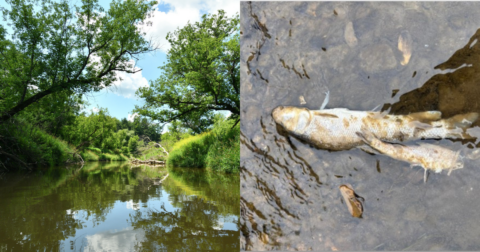Perspective
Can Men Help the Climate by Eating Less Meat?
Climate•5 min read
Heavy rain and 11,500 gallons of dairy cow manure per acre appear to have triggered the deadly spill.


Words by Nina B. Elkadi
At least eight miles of a Southwest-Wisconsin stream were polluted by a manure spill earlier this month. The spill killed hundreds of fish, including many wild brown trout. The affected waterways — Spring Valley Creek, Moore Creek and the Kickapoo River — have long been remarkable for their healthy water quality, healthy enough to sustain naturally-reproducing trout populations. The source of the spill appears to be manure applied to fields by a 600-head dairy operation near Norwalk, Ben Uvaas, who works at the Wisconsin Department of Natural Resources (DNR), tells Sentient. A “gully washer,” or massive rain event, appears to have triggered the runoff, he says. Though the farmer of the dairy operation took measures to protect soil health, the combination of heavy rains and 11,500 gallons of applied manure per acre were enough to trigger a spill.
This year, there have been at least 9 documented manure spills in Wisconsin, according to the DNR. The Kickapoo River, where some of this manure was observed, eventually carries water all the way to the Gulf of Mexico. Contaminants like manure and other agricultural byproducts contribute to an oxygen-depleted area known as the “dead zone” that can kill marine life. In 2024, the dead zone spanned 6,705 square miles.
On May 17, the DNR received a call about this spill to their violation tip line. The warden who received the call — a law enforcement official tasked with enforcing natural resources laws — went out to the stream, where they observed the hundreds of dead fish.
Uvaas works on the state DNR’s non-point source pollution program, referring to the kind of pollution that tends to be carried by rain or snowfall, according to the Environmental Protection Agency. The warden was able to track the source back to a farm field in Monroe County, southwest of Norwalk, Uvaas says. Wisconsin Public Radio reported the farm as Brueggen Dairy Farm, a 600-head cow operation.
Brueggen Dairy is not considered a concentrated animal feeding operation as it falls under the 700-head dairy threshold set by the EPA. In 2022, the operation received the Monroe County Conservation Farmers of the Year award.
On Monday, May 19, the DNR fisheries team examined most of the area — collecting hundreds of dead fish along the way. Spring Valley Creek, Moore Creek and the Kickapoo River, where the spill occurred, are prized trout habitats in a region that is a destination for fishers and other recreationalists.
So far, the investigation has determined that the week of May 11, a farmer injected approximately 11,500 gallons of manure, per acre, to around 130 acres of farmland. A Wisconsin DNR official recently said that anywhere from 12,000 to 15,000 gallons per acre is acceptable.
On May 14, the rain storm hit. Farmers frequently apply manure to their fields as fertilizer, but over-application can contaminate drinking water with nitrates, and high levels of ammonia can kill fish and other wildlife.
The farmer had been performing a range of what Uvaas describes as “soil health” practices meant to improve soil structure and the amount of manure applied does not appear to be beyond acceptable ranges. But the spill occurred anyway, illustrating that manure application has the potential to go wrong.
“Despite all our efforts to find the best time to apply (manure), Mother Nature is unpredictable,” Farm owner Randy Brueggen wrote in a statement to Wisconsin Public Radio.
“We as a dairy farm know how valuable this resource is, which is why we utilize incorporation practices in an intentional, safe and compliant manner,” Brueggen continued. “We strive to utilize our organic fertilizer over synthetic fertilizer for our crops. Our group’s farming practices always prioritize conservation. We want to sustain the land, so the land sustains us.”
In Wisconsin, “more than 1,500 miles of streams and rivers, and 33 lakes, in the nine counties assessed have impaired waters due overwhelmingly to combined pollution from manure and commercial fertilizer,” a 2022 investigation by the non-profit Environmental Working Group and non-profit law group Midwest Environmental Advocates found.
In the Driftless region of the Midwest, an area that covers parts of Northeast Iowa, Southwest Wisconsin and Southeast Minnesota, pollution containment and cleanup is especially difficult, Uvaas says. Unlike the rolling hills and lush soils of the Corn Belt, the karst topography is characterized by natural spring-fed streams, rocky bluffs and a thin layer of topsoil.
As a result, the streams are “fairly high gradient” and “high velocity,” says Uvaas, and this creates “an extremely narrow window” for response time, at least “compared to other parts of the state.” In the flatter parts of Wisconsin for instance, officials can put in barriers and collection sumps to collect contamination. But by the time DNR officials got to this site, it was too late. “There’s not any kind of collection or containment that’s feasible in the waterway, which is unfortunate, but that’s largely driven by timing and the topography here.”
Sentient is awaiting records from the Wisconsin DNR for more information regarding this spill, including enforcement action.